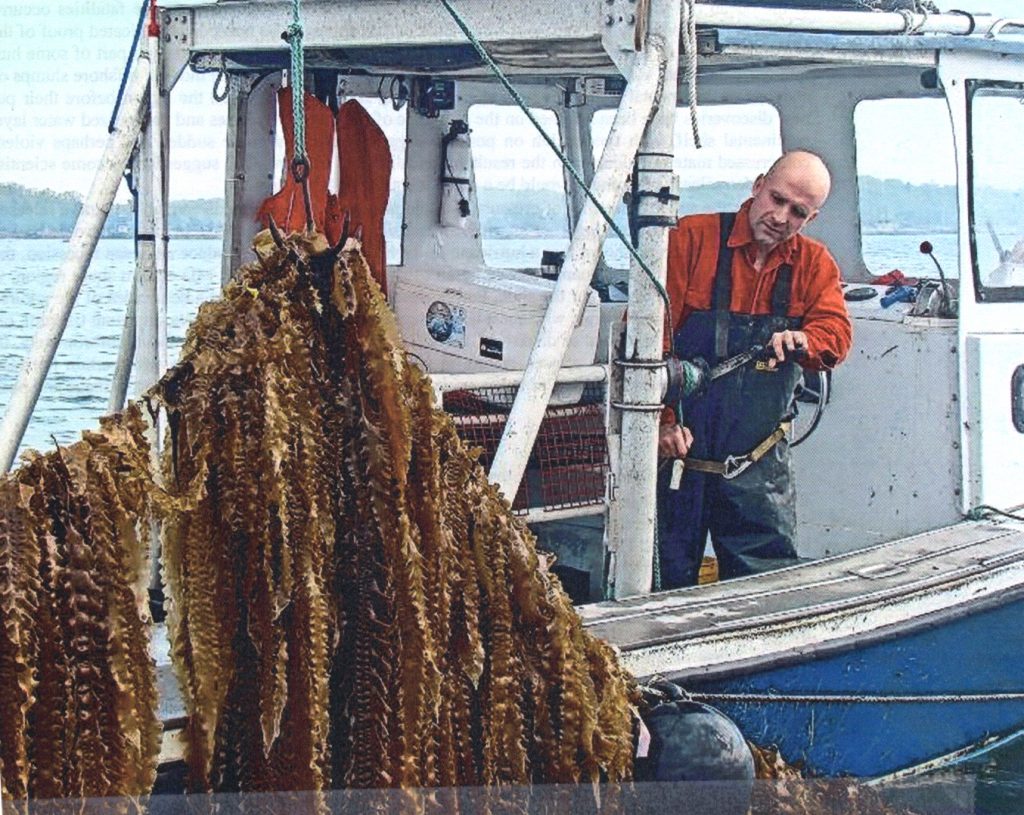
Since I last spoke with Bren Smith for the 2016 Seaweed article, he has written a book, “Eat Like a Fish,” which reflects his trajectory from a Newfoundland high school dropout who became a lobsterman, then a commercial fisherman in Alaska, went back to school and graduated from the University of Vermont and Cornell Law School. Along the way he developed the writing skills to put a book together that is so interesting you have trouble putting it own and so well written it generates an automatic eye roll when he defines himself as a poor student.

After time he enjoyed spending on crab boats, long liners and trawlers in Alaska he reflected on the other family members, all high achievers, and decided being a commercial fisherman was good, but he was always thought of as uneducated and catching up on his education was the only way to do that. His sister went to Harvard, his mother was promoted from secretarial work to being a publishing house manager and his father was the founder of the Linguistics Department at the University of Newfoundland. He traded his full time commercial fishing life in Alaska for part time summer employment fishing to pay for full time classes at the University of Vermont. A few years later Cornell Law School accepted him. He finished, graduated and decided law was not his field and never took the bar exams.
Smith’s first round of underwater farming, his oyster crop in the early 2000s, was so unsuccessful he called it “running a death camp.” Only a few oysters survived and a local chef, after trying one, said it was “disgusting.” Smith’s oyster cages were too heavy and they tipped over and fell into the muddy bottom. After he figured out how things worked and had a successful crop, he started the first Shellfish Community Fisheries program in the country. Like people buying shares at a farm and getting a box of produce at the end of the month, Smith provided monthly boxes of shellfish
Having rebuilt his oyster farm after major losses from Hurricane Irene, a little over a year later Superstorm Sandy destroyed every oyster and most of his gear. Not too many people can look back at the damage they suffered from Sandy and say, “Sandy is the best thing that ever happened to me.’
Like a farmer changing crops to accommodate changing weather conditions, Smith reimagined his oyster farm, adapting the design to incorporate other species that could cope with higher water temperatures and storm conditions. The new crop would have to be sustainable. His farm would need to deal with the storm surges of hurricanes and he developed and fabricated his own mold for concrete anchors. His system to grow a crop of oysters, mussels, scallops and later, kelp, meant the farm could be installed in three days, was cheap to put together and could be moved to deeper water to ride out storms.
The last seaweed article in 2016 ended with advice to eat kelp to live longer and healthier. Lately I’ve read more about the different edible seaweeds and current longevity statistics – better than they were five years ago. We all thought centenarians were the lucky people with good genes, but twin studies have found only 20% of our longevity is contributed by genetics. It’s our lifestyle choices that put us on the right or wrong path.
Since Japanese people are more likely to live to 100 or older, we should pay attention to their food choices. Diet is generally accepted as determining about 30% of how long we live. What can we learn from people who are obviously doing something right? Seaweed and fish are considered staples of the Japanese diet. The average Japanese person eats half a pound of fish a day, usually salmon, mackerel, octopus, eel or snapper. Fish swim in the marshes where they grow rice so it’s not a surprise that fish are a popular protein in Japan. Japanese people eat seaweed four or five times a week. Using nori to wrap their sushi, the Japanese also incorporate dried kelp into a variety of soups, stews and salads.
Raw kelp noodles are featured in salads and kombu, a dried form of kelp in the form of flakes, is sprinkled onto foods like chicken. It acts as a flavor enhancer and combines with chicken fat released while chicken is in the over to crisp the onion and potato cooking in the same pan. Kelp is the most readily available. kombu is commonly eaten in Japan. Seaweed salads imported from Asia have often been doctored with dyes and corn syrup. A seaweed salad should taste as though it came from salt water, not like a candy bar. Kelp can be frozen, defrosted and refrozen without losing its cellular structure or taste. Once thawed, kelp can be used as a vegetable or as stuffing for fish. If you are making your own sushi, you will find nori is expensive because it’s imported from Southeast Asia. Kelp can raise your energy levels and boost your brain function. In Okinawa they eat more kombu than anywhere else in the world.
For use in this country seaweeds are sold in a variety of outlets. Amazon sells wakame ready to eat seaweed salad for $5.99. They also sell begs of organic kombu kelp flakes cultivated from premium quality seaweed for $13.90 that you can eat right out of the bag. Little bags of seaweed snacks, some made by the Anna Chun Company that specializes in Asian foods, are sold at Wal-Mart and Dollar Stores. Other seaweed snacks are sold at Trader Joe’s. Fresh frozen kelp is available through Atlantic Sea Farms (atlanticseafarms.com) and fresh at the Stonington Connecticut farmers market.
Here are two recipes that won’t take your American taste buds out of their comfort zone.
Seaweed Soup
4 Tbs Seaweed Soup Mix 3 slices of ginger root
3 Tbs rice or barley 1 Medium onion thinly sliced
3 Shitake mushrooms 3 Tbs sesame oil
3 Cloves of garlic 2 sliced carrots, parsnips, turnips
Handful of chives, cut small Beets
Handful of curley parsley cut small ½ cup soy sauce
Put two quarts of water in a four-quart pot. Add Soup Mix and rice or barley, ginger, mushrooms, and garlic. Turn on the heat and when it comes to a boil, turn it down. When the mushrooms are rehydrated, remove, slice and return to the pot. In a separate pan add everything but the parsley and chives. Cook until soft, put into the soup and then add the parsley and chives.
Lemon Seaweed Pasta
1 pound rigatoni 5 anchovy fillets, chopped
3 cloves of garlic, grated 1-1/2 Tsp lemon zest and juice to taste
¼ cup olive oil
½ cup kelp puree
½ cup finely chopped parsley
4 Tbs butter
Kosher salt to taste
Cook pasta until just shy of al dente – usually two minutes less cooking time than directions suggest. Reserve a cup of pasta water and drain the rest. Make a paste of the anchovy fillets, garlic and lemon zest. In a 12” skillet heat ¼ cup of olive oil and add anchovy paste and cook for two minutes. Add butter and parsley. Add pasta and coat pasta. If dry, add pasta water a little at a time.
Taste and if needed add more lemon juice and salt.
